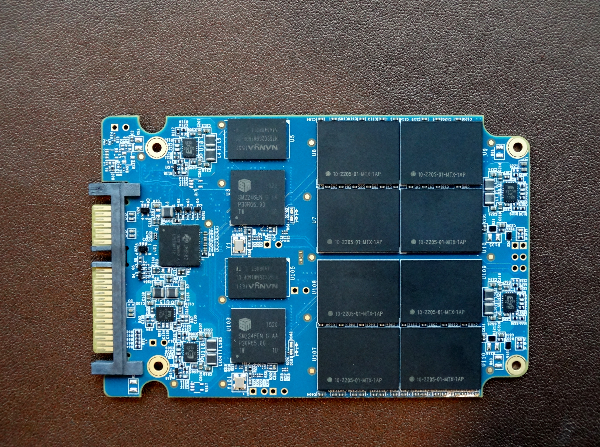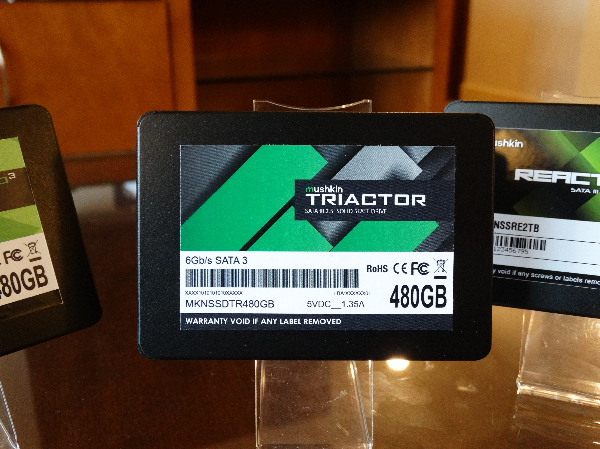Mushkin Goes For The SSD Trifecta At CES
Mushkin is an old-school gaming-focused company that has a long history and many fans of its products. The company's memory products were once considered a staple for overclockers, but in recent years the solid-state products have come to the surface and become main products in the stable.
Mushkin plans to release several new products in 2016 and will bring many to market with new 3D flash memory from Micron, Intel, Toshiba and SK Hynix. One of the first products we'll see is a larger capacity Reactor. The Reactor 1 TB currently sits on our Best SSDs chart for its large capacity size and very low price. Reactor will expand in 2016 to 2 TB with new 3D flash memory, but we may also see a special 4 TB model at some point.
The 4 TB Reactor will pair two Silicon Motion, Inc. SM2246EN controllers behind a JMicron RAID controller. The company told us it will still try to target the 25-cents-per-gigabyte mark like the current Reactor products, but time will tell. Flash is a volatile market with many ups and downs.
We don't have any timeline or performance details but suspect the new dual-controller drive will suffer from low random performance due to the low-cost JMicron JMS562 eSATA to dual SATA bridge used to RAID the two SMI controllers. Still, with 4 TB on tap, we would love to fill a 10GbE connected NAS with these drives and give it a go.
Mushkin's Phison S10-controlled drive, Striker, will also see its capacity double in 2016. After overprovisioning that increases performance, the Striker SSD will scale up to 1920 GB. This gives Mushkin a high performance SATA SSD in the 2 TB capacity class product range. This too will rely on 3D flash from several vendors.
Mushkin plans to release two 3-bit per cell SSDs in early 2016. The first shown above, Triactor (get it?) will use an SMI SM2256 controller and TLC flash. This model will ship worldwide and should sell for even less than the Reactor that is already one of the lowest cost SSDs sold today.
The Mushkin ECO3 will be a Newegg Exclusive but will use nearly the same configuration as the Triactor. When companies list products exclusively with Newegg, the reseller will chip in with some extra promotion. Having the ECO3 highlighted in email blasts and giving preferred placement on the site will help it become a popular product for those looking to save some money with TLC flash products.
Get Tom's Hardware's best news and in-depth reviews, straight to your inbox.
It seems that every company has a prototype E7 drive around to show off. The Phison E7 is gearing up for a big launch with products coming from several companies including Mushkin. This will be an almost SF-2281-like launch, but that is great news for consumers looking for a great SSD at an even better price. Mushkin has shown the E7 a number of times, so there really isn't anything new from the company about the drive. Phison did state that the E7 should ship in retail around March of this year. This will bring NVMe technology to a wider audience because the drives should cost less than Intel's SSD 750 and Samsung's 950 Pro, the two shipping NVMe protocol products currently shipping in volume for client workloads.

Chris Ramseyer was a senior contributing editor for Tom's Hardware. He tested and reviewed consumer storage.
-
Nintendork As long as it's done with reliability in mind, I don't care about high performance in big size SSD's. Maybe they should focus on that part of the market, drive the price down in archival SSD's.Reply
Sadly making an SSD with 250MB/s max cost the same as one saturating the sata 3 bus (nand prices). -
Lutfij Now that is a brand I haven't heard from in a long while. Its good to know Mushkin is still trying to up its game and beating competitors in the price arena. I do have one gripe with that brand though - they make stellar ram kits in terms of aesthetics but their SSD's could use an overhaul in design.Reply -
Tim_12 "Sadly making an SSD with 250MB/s max cost the same as one saturating the sata 3 bus (nand prices). "Reply
I used to think that too, that NAND was all the same and it really came down to the controller, how many channels it has access to the NAND through, caching algorithm's, etc.
But NAND, especially TLC, is heavily binned for performance. That's why you see such a vast performance difference with TLC drives that all use the same Silicon Motion controller. MLC was and still is binned for to separate performance drives from economy drives, and that's why you see so many MLC drives selling at TLC drive prices. And in those cases, you are always better off with even a lower-binned MLC drive than a highly binned TLC drive because MLC will always outlast TLC, and no matter how aggressive the controller firmware is (SLC caching, DRAM cached indirection table, 8 channel interface, etc) TLC will always have poor write performance compared to MLC. Always.





